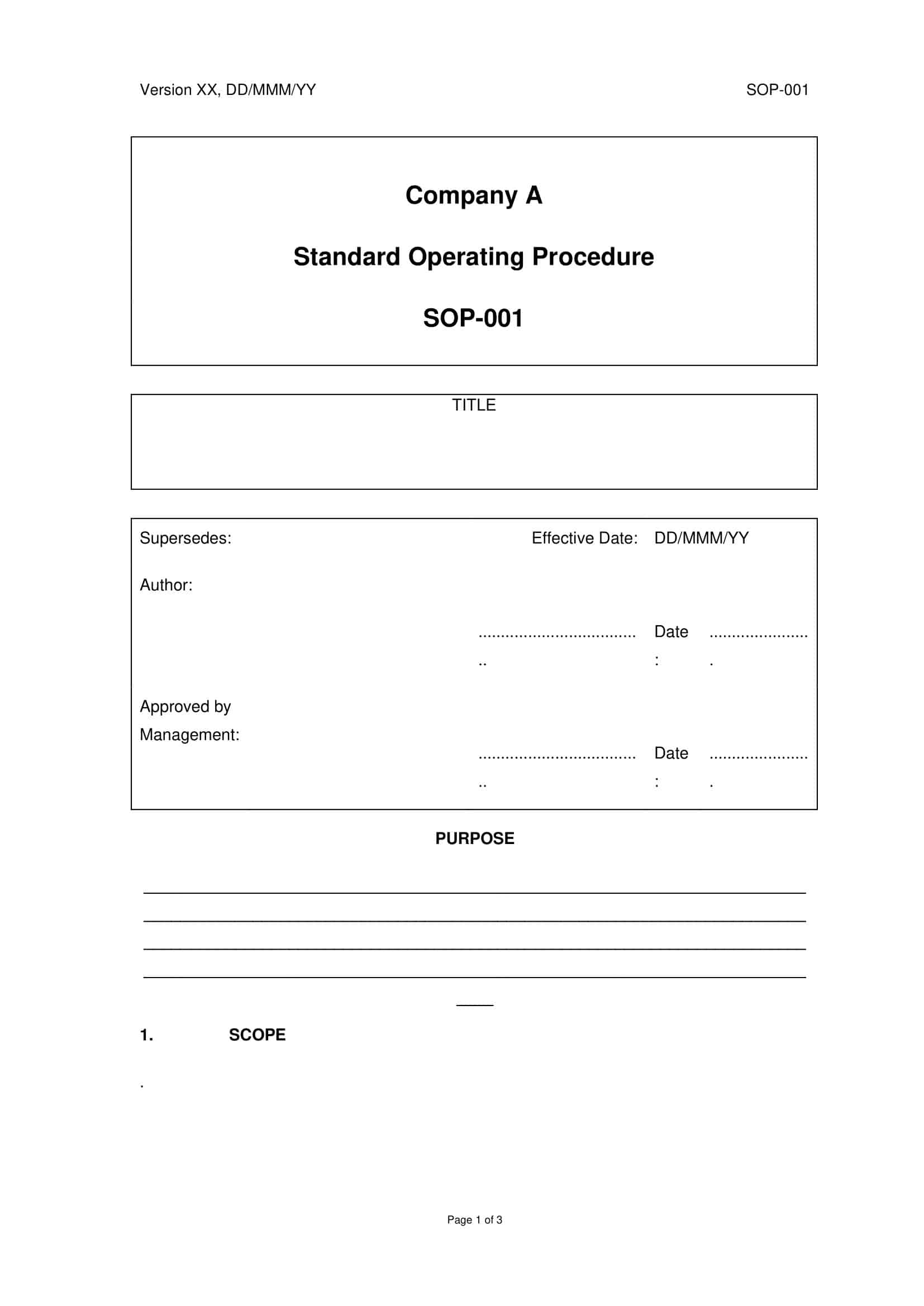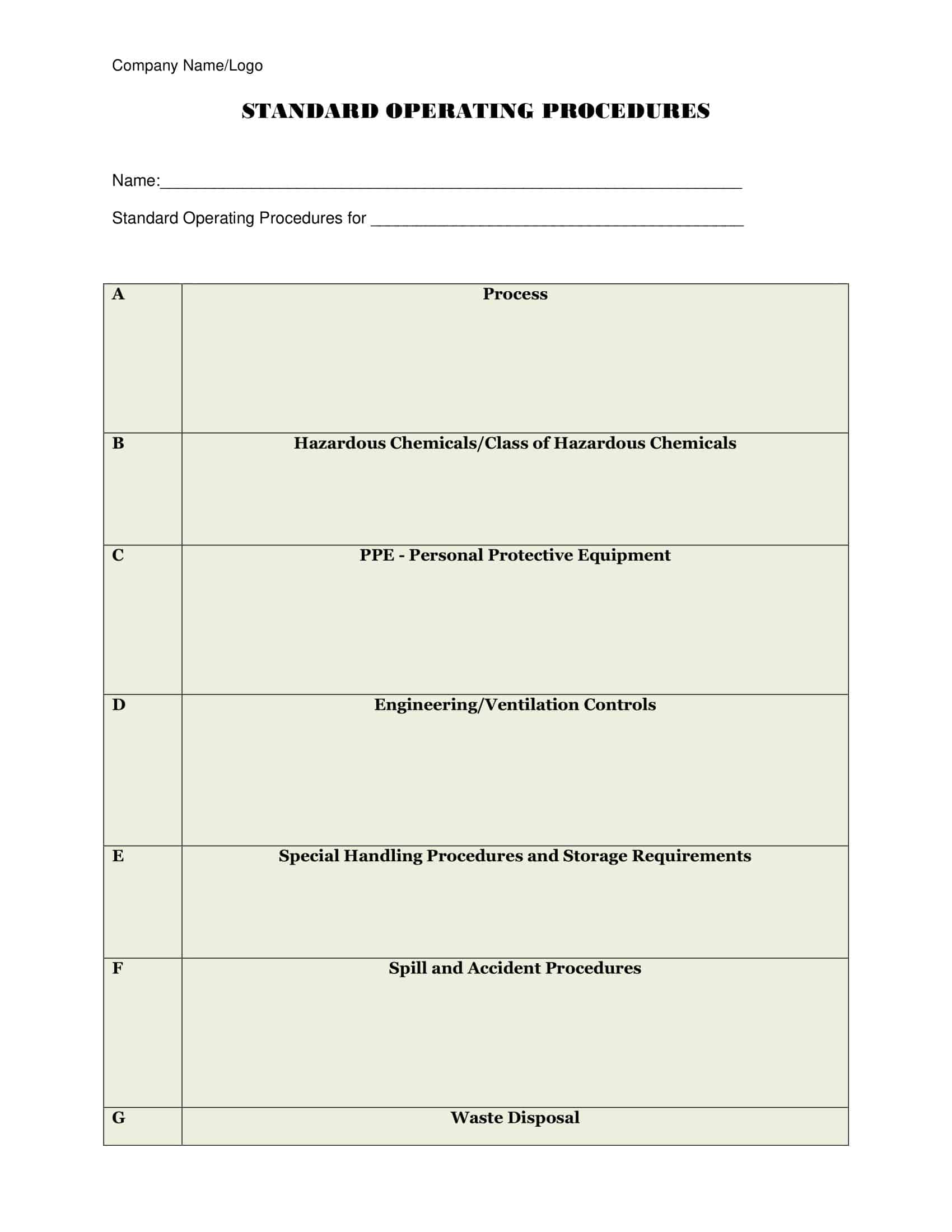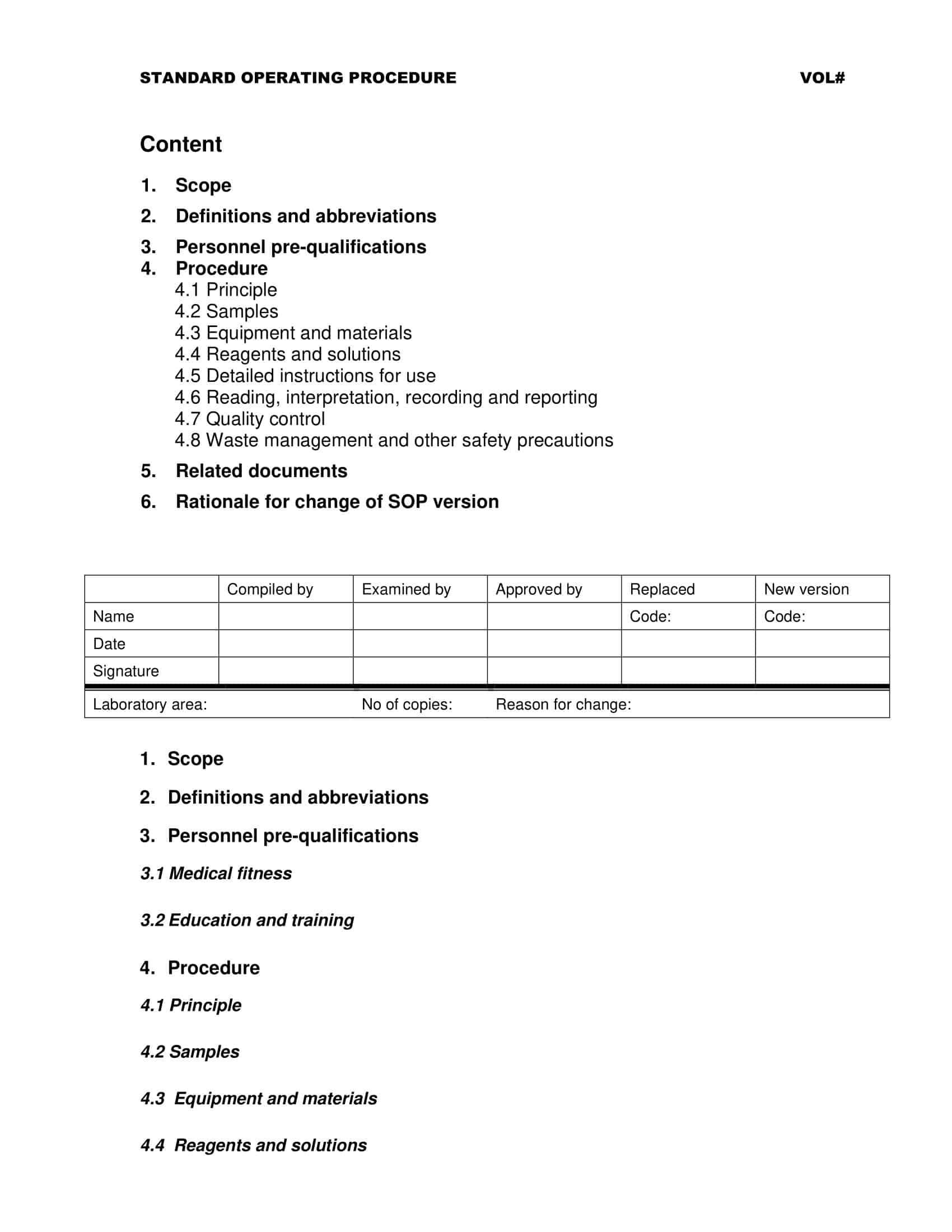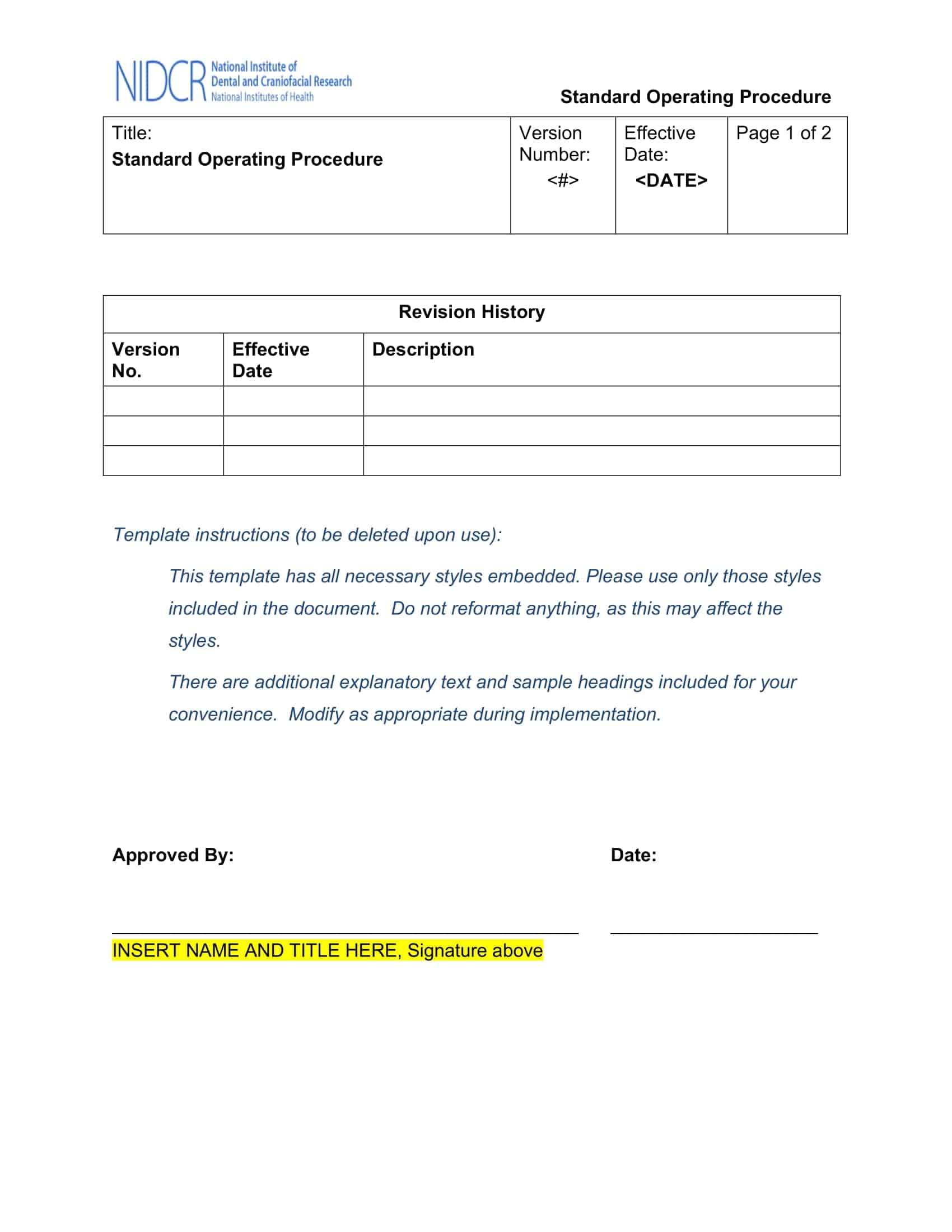When operating in a commercial business or institution, you may feel that it is necessary to implement standardized procedures to ensure that certain activities are performed according to specific desired standards.
The standardized procedure ensures consistency and maintenance of certain desired standards in producing a given product or providing certain services. This page details standard operating procedures, why they are important, when they should be used and how you can use them effectively.
Table of Contents
Standard Operating Procedures (SOPs) Templates
Standard Operating Procedures (SOPs) Templates are pre-designed formats used by organizations to document and communicate the step-by-step processes and guidelines for specific tasks or activities. These templates provide a structured framework for creating clear, consistent, and standardized procedures that ensure efficiency, quality, and compliance within an organization. SOPs Templates outline the required actions, responsibilities, and best practices for performing various operations, enabling employees to follow standardized procedures and achieve consistent results.
Standard Operating Procedures (SOPs) Templates provide a systematic and consistent approach to documenting and communicating processes within an organization. By using these templates, organizations can standardize procedures, ensure compliance with regulations or standards, and promote efficiency and quality in their operations. SOPs Templates facilitate clear instructions, enhance productivity, and enable effective knowledge transfer among employees. These templates serve as valuable tools in promoting consistency, improving training and onboarding processes, and maintaining organizational effectiveness and compliance.
What Are SOPs? (Standard Operating Procedures)

The standard operating procedure covers the rules to be followed during disasters and disasters. However, the whole of engineering applications ensures the up-to-dateness of the records to be taken. In this case, they are updated documents that are constantly revised by creating processes to increase performance and improve quality.
How Do Work Instructions Work (WI)?
Work instructions (WI) are detailed and linked to the SOP. In addition to describing activities and those responsible for them, these documents provide more details about tasks, including aspects such as execution mode and time. In other words, WI shows “how” activities are carried out.
Based on a user manual, work instructions should use simple language and be written using an uncomplicated step-by-step process with the information needed to perform the task. Pictures, photographs, and tables can be used to make it even easier for the employee to understand.
What is the difference between SOP and WI?
Although they share similar structures, WI and SOP generally have different functions. Therefore, the hierarchy of these documents is different, especially in Quality Management System Documentation. Below is an example of a hierarchy structure:
- Level 1 = Quality Assurance Manual: The starting point for goals, objectives, and responsibility.
- Level 2 = Procedures (SOPs): Interaction between departments/business units in terms of inputs/outputs.
- Level 3 = Business Instructions (WIs): Documents describing how business objectives are achieved.
- Level 4 = Records: Evidence of eligibility.
Thus, WI’s are at a sub-procedural level, and the distinction between these documents is based on their use and degree of detail. While the former applies to operational activities and provides rich detail, SOPs are responsible for standardizing management processes, with the distinction of being the standard of a system.
Both can be applied at all stages of the process and try to get people to do the same task in the same way. So in terms of legislation, there is no difference between the two terms.
How to Use SOP and WI?
Regardless of the person responsible for carrying out the activity, companies need to have well-defined standard documents, irrespective of the field of business, as they help them understand how to perform routine tasks safely, safely, and consistently.
Although there is no official document with guidelines for preparing these documents, these are some tips that can help you plan an effective standardization model.
List all activities and processes to be documented;
Seek help from employees involved in the process/activity to prepare a highly detailed document that reflects reality;
Observe the on-site activity to get a baseline in reality;
Recognize the public to use documents and adequate language;
Whenever possible, use tables, flowcharts, images, and photographs to facilitate understanding and ease;
Always update documentation and train employees after each new revision;
Where appropriate, mainly use references in SOPs;
Verify if there are any procedures or instructions in rules or legislation that must convey certain information;
Document procedures, processes, work instructions, and records as needed;
Make sure documents are easily accessible to people who need access.
An automated solution assists in the preparation, organization, management, and control of documents, ensuring that anyone can easily find documents when needed, by each one’s level of security.
How is SOP Prepared?
The SOP, called the standard operating procedure, is the record that should be kept with the work to be done in case of disasters and hazards. Things to consider while preparing the standard operating procedure;
- Clear information should be given; unnecessary extensions should be avoided.
- While writing the letter of intent, copies and quotations should not be made.
- Must be shown to be able to cope with reading difficulties at an international university.
- You need to make an impact by telling your passions about your chosen department.
Conclusion
SOPs have an important place in the disaster and emergency management system. In particular, SOPs, which are suitable for the targeted purpose, complete and complete, up-to-date and easy to understand, function very well in disaster management. SOPs written before a disaster are indispensable to get rid of the chaos when disaster strikes and respond more effectively and quickly.
At the time of the disaster, if no work has been done before, many lives and resources may be lost, and psychological wounds that cannot be recovered may occur due to the poor coordination between institutions. However, as a fact in disaster management, if the fact that individuals and societies that are prepared for disasters can return to everyday life much faster and faster, SOPs can be implemented in holistic disaster management by setting the procedures by setting standards beforehand, who will do what, where and how. Therefore, its role in facilitating the return of disaster-affected communities to normal life and minimizing the loss of life and property is important.
Of course, since the problems to be encountered in each hazard are different, SOPs should be made separately for each possible threat. For example, an SOP written for flooding may not produce appropriate solutions in an earthquake. The SOP to be used during an earthquake cannot be applied during a landslide. The SOP written against a possible earthquake in an industrial area must differ from the SOP written for residences in the same region.
For whatever reason, the written SOPs must be kept up to date. For example, suppose it is considered that it is difficult to work in an area where there are problems, confusion, psychology of dereliction, loss, and similar emotional traumas encountered during a disaster. In that case, the fact that SOPs are far from confusion and loss, are solution-oriented, and have a structure that can minimize all the confusion in the environment is an issue that depends on people. Therefore, it is necessary to prepare it systematically, not in a way that will not be affected by the changes in the system. In addition, when SOPs are not written, accidents, unnecessary expenses, and personnel problems increase, and a professional environment is increasingly removed. This reduces the performance of the work to be done.
In this study, SOP development methods were tried to be explained by considering previous studies and examinations about SOP writing rules.
Has been made. As a result, it has been understood that SOPs play a quality-enhancing role even in permanent and temporary personnel changes.
It is necessary to carry out more studies on this subject, to carry out these studies both in universities and in public and private institutions, and the increasing interest in studies on disaster management in our country should be reflected in this issue.
Managers in organizations should form teams to conduct periodic reviews of procedures once a year. Each team must find the up-to-date procedures and the solution that will be the best solution. As a result, SOPs;
• It should not be forgotten that the main purpose is to increase quality.
• It needs to be strengthened and revised by the management.
• It must comply with the relevant laws, regulations, and other standards. These studies should be used.
• Employees should be made to believe that this is a useful thing. Employees should be involved.
• They should be written by someone or someone who has knowledge about the work to be done.
• It should be kept in mind that it can be used as an educational tool.
• All previously prepared SOPs should be kept in a file.
• SOPs should be tried once or twice before they are generally used.
• SOPs should be easily accessible.
For the bad effects of disasters to not increase anymore, it is now necessary for all kinds of disaster-related efforts to be efficient, energy not to be wasted in this direction, and for the world to become more livable with these simple works.
Operation procedure; It provides convenience in dealing with dangers in terms of life, property, or business continuity. The SOP, in its techniques, regulates the method by which standard operating procedures should be carried out and what they cover. They are the systems in which records are made about what needs to be done throughout the country and how the work is carried out.
FAQs
What is SOP format?
The standard SOP format includes a title, purpose statement, scope, responsibilities, procedures, and definitions. Formats vary by industry and organization, but SOPs generally follow a formal outline structure for consistency.
Is there an SOP template in Word?
Yes, Word has downloadable SOP templates that provide an outline format including fields for the procedure title, purpose, scope, responsibility, materials, safety warnings, the step-by-step instructions, approvals, and more. The templates can be customized.
What are the 5 parts of SOP?
The five main parts of a standard operating procedure are typically:
- Title
- Purpose Statement
- Scope
- Responsibilities
- Procedures
How to write a SOP?
To write a SOP:
- Establish the procedure title, purpose, scope
- Define roles and responsibilities
- List required materials and equipment
- Provide safety information if applicable
- Outline the steps in a logical sequence using numbered lists
- Add images if helpful
- Have approvers review and sign-off on the SOP
- Distribute finalized SOP and train staff on procedures



















































![Free Printable Credit Card Authorization Form Templates [PDF, Word, Excel] 1 Credit Card Authorization Form](https://www.typecalendar.com/wp-content/uploads/2023/06/Credit-Card-Authorization-Form-150x150.jpg)
![Free Printable Stock Ledger Templates [Excel,PDF, Word] 2 Stock Ledger](https://www.typecalendar.com/wp-content/uploads/2023/08/Stock-Ledger-150x150.jpg)
![Free Printable Financial Projections Templates [Excel, PDF] 3 Financial Projection](https://www.typecalendar.com/wp-content/uploads/2023/05/Financial-Projection-1-150x150.jpg)
